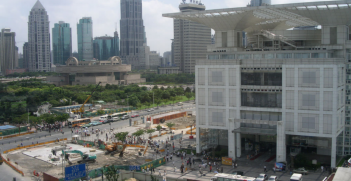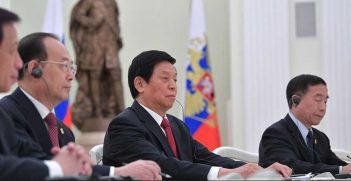We Are Overestimating the Belt and Road Initiative and Beijing’s Capability to Do Everything

China’s Belt and Road Initiative (BRI) may seem part of a “grand strategy” of expansionism threatening to destabilise the liberal international order. But upon closer inspection, it appears China’s strategy towards such global leadership is restricted by factors beyond its control.
2020 saw a gradual deterioration in relations between the People’s Republic of China and countries of the Western world. China and Canada celebrated their 50th anniversary of diplomatic ties by exchanging insults and threats over unresolved matters, which has become customary ever since the arrest of Huawei’s CFO. Canberra also continued to lock itself in a diplomatic war with Beijing after the Morrison government volunteered to lead the charge for an investigation into China’s responsibility for COVID-19. As for the United States, the world has become so used to its quarrels with China that not even an extreme executive order, such as the one banning TikTok, was much of a surprise. While the PRC does deserve to be called out in many circumstances, doing so has proven to cause more harm than good to all parties. Yet, it seems that facing an increasingly assertive China in international affairs, even to the extent of utilising containment efforts which are self-destructive, is justifiable.
However, before letting the fear of a Chinese-led world order seep in, it might be wise to understand the basis of such a fear. One prominent factor that made the “China threat” theory so credible, to the point that it incentivised leaders of the Western world to take a tougher stance on China, was none other than Xi Jinping’s master plan, the Belt and Road Initiative (BRI). The common perception is that through the BRI, China has launched a grand strategy to expand its sphere of influence in an attempt to replace the US as the global hegemon. But regardless of how much it might seem like one, the BRI is not, or rather cannot, be China’s grand strategy.
Examining China’s domestic settings, the lack of institutionalised policy authority and reliance on personal support greatly infringes on leaders’ capability to generate a coherent, detailed, top-down policy. While Xi is not just any leader, often being compared to Chairman Mao for his ability to concentrate power in his own hands and exert tight jurisdiction over his subordinates, one man alone cannot overturn decades of political customs, nor control all policy outcomes. The BRI might be set out to fulfil Xi’s ambition to place China back to the centre of the world, living up to its name as the “Middle Kingdom.” But to implement it would require support and resources from other actors, who might not have any fanciful vision for China’s stature in the world.
These actors are Chinese state capitalists, more specifically, commercial banks, local governments, and state-owned enterprises (SOEs). Deeply involved in the BRI due to their important role in financing and implementing the initiative, these actors have been able to take advantage of the BRI, using it to resolve their internal problems in ways that undermine key foreign policy goals. Indeed, for many years, overinvestment and subsequent overcapacity in mainland China has jeopardised provincial governments and their SOEs. As these loss-making SOEs financed their operations through money borrowed from state-owned commercial banks at a favourable rate, their failing businesses also caused mounting debts which posed threats to the Chinese banking system. In light of this scenario, the BRI has presented a golden opportunity for struggling state capitalists to access lucrative tied aid contracts and to internationalise their surplus capability.
Recent research into the policy formation process of the BRI has found that state capitalists were trying to lobby and mould the initiative to their liking soon after it was announced. When the official plan for the BRI, entitled “Vision and Actions on Jointly Building Silk Road Economic Belt and Twenty-First Century Maritime Silk Road” (hereafter V&A), was published in 2015, it became clear that the geopolitical visions of paramount leaders had been compromised. Expected to be a detailed blueprint of the BRI, the V&A was laid out in an extremely broad and vague manner to accommodate diverse politico-business interests. It established no time frame or criteria for BRI projects, raised the number of included provinces to the BRI from 14 to 27, and also raised the number of eligible partner countries from 65 to every single country on Earth.
More partners mean more projects, and more projects means more subsides. But while the expansion of the BRI profits state capitalists handsomely, it has departed the plan significantly from top leaders’ wishes. Instead of focusing on the six economic corridors that are the essence of the BRI, money is increasingly being funnelled into reviving failed domestic projects that contribute little to nothing to China internationally. For example, under the slogans of the BRI, the Hunan government and SOE Hunan Railways were offered a loan of US$1.3 billion to resume their railway project. In the same way, another 34 highways and eight railways projects in Hunan successfully obtained government subsidies that year. In Gangsu, a failing steelmaker pitched to BRI financing groups in efforts to expand internationally and was also given new funding to stay afloat, despite market saturation and pollution.
Economic short-termism has dominated the BRI plan. In 2017, Beijing forbade the publication of any BRI maps. But if we were allowed to draw one, the current BRI map would be a bunch of scattered dots, reflecting the fragmented, incoherent plan that is the BRI today.
Knowing what the BRI is truly driven by could fundamentally change the Western narrative of China as an aggressive threat to the established liberal world order. China’s acquisitions of ports in Sri Lanka or Greece, for example, are often seen as strategic wins for Beijing, evidence of China’s debt-trap diplomacy, and military expansionism. In reality, those takeovers are “poorly designed projects, driven by economic short-termism and approved within a weak, fragmented governance environment.” They have burdened the recipient states with white elephants and forced the Chinese government to bail them out, a far cry from popular notions of the BRI being a grand strategy with projects meticulously calculated from the top down to achieve geopolitical ends.
Western analysts have overestimated Beijing’s capacity to create and implement a grand strategy. And with this overestimation comes the tendency of overreacting to China’s actions in international affairs. Although it might be naïve to tell countries to worry less about China, a credible assessment of a threat needs to be derived from careful considerations of evidence and facts, not the fear of underestimating your enemy.
Minh Phuong Vu is an intern at the Australian Institute of International Affairs National Office. She is currently studying a Master of International Relations at the Australian National University. Her research interests are territorial disputes in the South China Sea and China’s relations with ASEAN countries.
This article is published under a Creative Commons License and may be republished with attribution.





